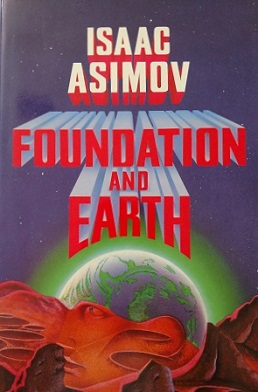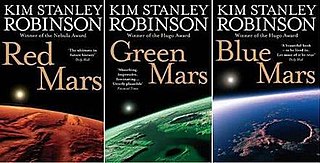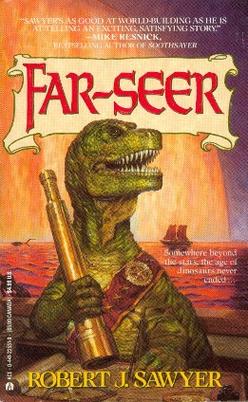
Foundation and Earth is a science fiction novel by American writer Isaac Asimov, the fifth novel of the Foundation series and chronologically the last in the series. It was published in 1986, four years after the first sequel to the Foundation trilogy, which is titled Foundation's Edge.

The Mars trilogy is a series of science fiction novels by Kim Stanley Robinson that chronicles the settlement and terraforming of the planet Mars through the personal and detailed viewpoints of a wide variety of characters spanning almost two centuries. Ultimately more utopian than dystopian, the story focuses on egalitarian, sociological, and scientific advances made on Mars, while Earth suffers from overpopulation and ecological disaster.

Regeneration is a historical and anti-war novel by Pat Barker, first published in 1991. The novel was a Booker Prize nominee and was described by the New York Times Book Review as one of the four best novels of the year in its year of publication. It is the first of three novels in the Regeneration Trilogy of novels on the First World War, the other two being The Eye in the Door and The Ghost Road, which won the Booker Prize in 1995. The novel was adapted into a film by the same name in 1997 by Scottish film director Gillies MacKinnon and starring Jonathan Pryce as Rivers, James Wilby as Sassoon and Jonny Lee Miller as Prior. The film was successful in the UK and Canada, receiving nominations for a number of awards.
Foreigner most commonly refers to:

Robert James Sawyer is a Canadian and American science fiction writer. He has had 24 novels published and his short fiction has appeared in Analog Science Fiction and Fact, Amazing Stories, On Spec, Nature, and numerous anthologies. He has won many writing awards, including the best-novel Nebula Award (1995), the best-novel Hugo Award (2003), the John W. Campbell Memorial Award (2006), the Robert A. Heinlein Award (2017), and more Aurora Awards than anyone else in history.
A bioship is a type of spacecraft or starship described in science fiction as either predominantly or totally composed of biological components, rather than being constructed from manufactured materials. Because of this, they nearly always have a distinctively organic look.
The Space Trilogy is a series of science fiction novels by C. S. Lewis. The trilogy consists of Out of the Silent Planet (1938), Perelandra (1943), and That Hideous Strength (1945). A philologist named Elwin Ransom is the protagonist of the first two novels and an important character in the third.

The Divine Invasion is a 1981 science fantasy novel by American writer Philip K. Dick. It is the second book in the gnostic VALIS trilogy, and takes place in the indeterminate future, perhaps a century or more after VALIS. The novel, originally titled Valis Regained, was nominated to the BSFA Award.
The Noon Universe is a fictional future setting for a number of hard science fiction novels written by Arkady and Boris Strugatsky. The universe is named after Noon: 22nd Century, chronologically the first novel from the series and referring to humanity reaching its noon in the 22nd century.

Saturn has made appearances in fiction since the 1752 novel Micromégas by Voltaire. In the earliest depictions, it was portrayed as having a solid surface rather than its actual gaseous composition. In many of these works, the planet is inhabited by aliens that are usually portrayed as being more advanced than humans. In modern science fiction, the Saturnian atmosphere sometimes hosts floating settlements. The planet is occasionally visited by humans and its rings are sometimes mined for resources.
This is a list of fictional stories in which solar eclipses feature as an important plot element. Mere passing mentions are not listed.
A flag of Mars is a concept of a possible flag design, meant to symbolize the planet Mars or to represent a fictional Martian government, in works of fiction.
The Quintaglio Ascension Trilogy is a series of novels written by Canadian science fiction author Robert J. Sawyer. The books depict an Earth-like world on a moon which orbits a gas giant, inhabited by a species of highly evolved, sentient Tyrannosaurs, among various other creatures from the late Cretaceous period, imported to this moon by aliens 65 million years prior to the story. The series consists of three books: Far-Seer, Fossil Hunter, and Foreigner.
The fictional portrayal of the Solar System has often included planets, moons, and other celestial objects which do not actually exist in reality. Some of these objects were, at one time, seriously considered as hypothetical planets which were either thought to have been observed, or were hypothesized to be orbiting the Sun in order to explain certain celestial phenomena. Often such objects continued to be used in literature long after the hypotheses upon which they were based had been abandoned.

Fossil Hunter is a novel written by Canadian science fiction author Robert J. Sawyer. The sequel to Far-Seer, it is the second book of the Quintaglio Ascension Trilogy. The book depicts an Earth-like world on a moon which orbits a gas giant, inhabited by a species of highly evolved, sentient Tyrannosaurs called Quintaglios, among various other creatures from the late cretaceous period, imported to this moon by aliens 65 million years prior to the story. Originally published in 1993 by Ace Science Fiction, it won the Homer award for "Best Novel" during its initial release date. It was reissued in 2005 by Tor Books.

Far-Seer is a novel written by Canadian science fiction author, Robert J. Sawyer. It is the first book of the Quintaglio Ascension Trilogy, and is followed by two sequels: Fossil Hunter and Foreigner. The book depicts an Earth-like world on a moon which orbits a gas giant, inhabited by a species of highly evolved, sentient Tyrannosaurs called Quintaglios, among various other creatures from the late Cretaceous period. Originally published in 1992 by Ace Science Fiction, it won the Homer award for "Best Novel" during its initial release date. It was reissued in 2004 by Tor Books.
"Uphill Climb" is a 1987 short story written by Canadian science fiction author Robert J. Sawyer. It is the first print appearance of the Quintaglios, a species of sentient dwarf tyrannosaurs, which would later star in his critically acclaimed Quintaglio Ascension Trilogy. It was later reprinted in Iterations, an anthology of short stories written by Robert J. Sawyer.

Ancient astronauts have been addressed frequently in science fiction and horror fiction. Occurrences in the genres include:
The WWW Trilogy is a trilogy of science-fiction novels by Canadian science fiction author Robert J. Sawyer. The first book, Wake, was originally serialized in four parts in Analog Science Fiction and Fact from November 2008 to March 2009, published in book form through Ace on April 7, 2009 and was followed by the second book, Watch, on April 6, 2010. Wonder was published in 2011.

Wake, also called WWW: Wake, is a 2009 novel written by Canadian novelist Robert J. Sawyer and the first book in his WWW Trilogy. It was first serialized in four parts in Analog Science Fiction and Fact from November 2008 to March 2009, was first published in book form on April 8, 2009, and was followed by Watch in 2010 and by Wonder in 2011. The novel details the spontaneous emergence of an intelligence on the World Wide Web, called Webmind, and its friendship with a blind teenager named Caitlin.










